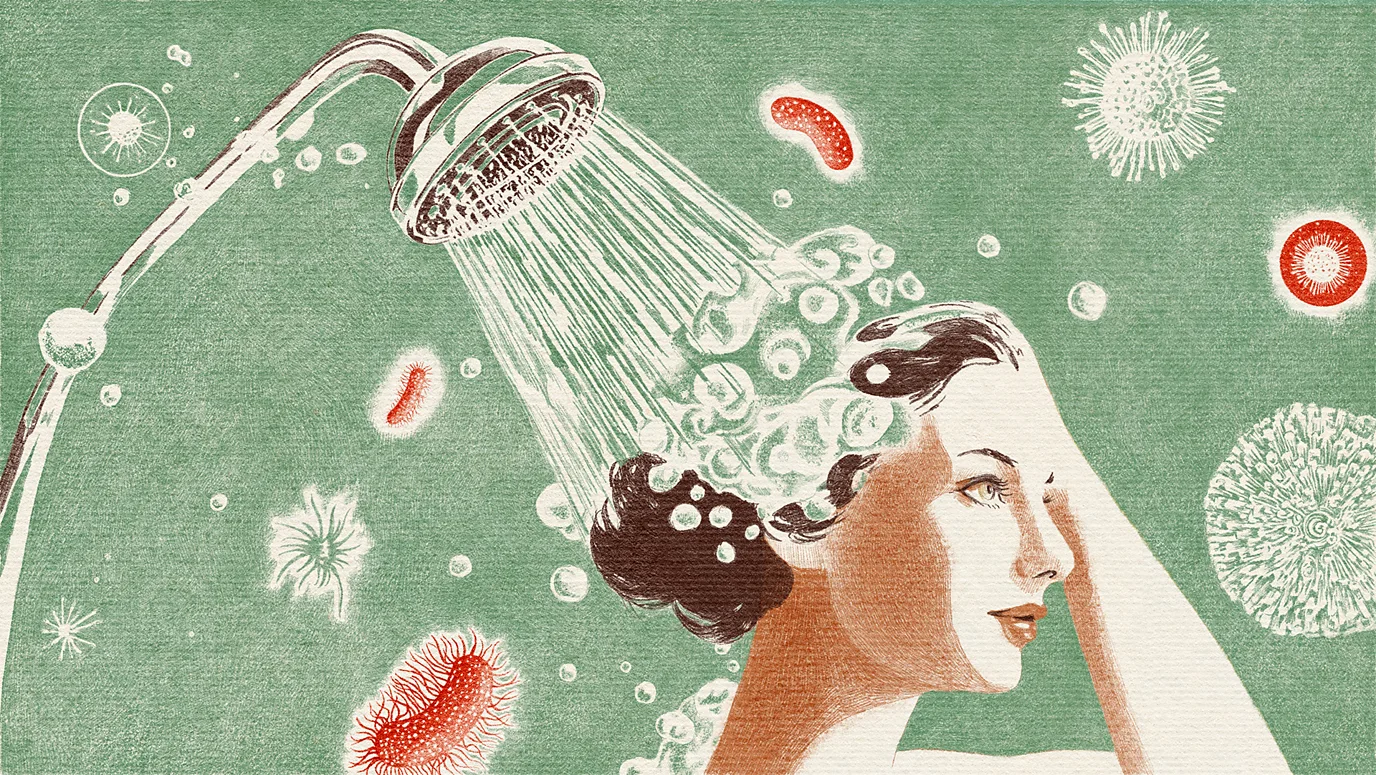Your shower head and the pipes leading into it are a haven for bacteria and fungi. But some simple tricks can flush them down the drain.
When most of us jump in the shower, we do so with the expectation of becoming clean. That seems reasonable – after all, hot water plus steam and soap should equal a fresh and sweet-smelling you. The last thing one expects is a plume of bacteria exploding onto your face. Yet that is exactly what happens when you turn on the tap.
Inside the last metre of your plumbing, a tiny ecosystem lurks, just waiting for you to switch on the hose. it means the first blast from a morning shower isn’t just water and steam.
Overnight, a living film of bacteria builds up inside the shower hose and head. Some of these microbes then hitchhike on the droplets that your shower creates. Most are ordinary and harmless. However the exact microbial mix depends on the hose material and how often you shower– and that’s where the surprises begin.
Shower heads and hoses are prime real estate for bacteria. After you’ve showered, the hose remains warm, wet and undisturbed for hours at a time.
Its long, narrow coil provides ample rough surface for microbes to colonise. Once there, bacteria feed on dissolved nutrients in the water, as well as tiny amounts of carbon that leach from the plastic shower hose. Leave that system to stagnate overnight and microbial communities establish quickly. The bacteria form biofilms – gooey microscopic microbial “cities” that cling to almost any wet surface, from the hulls of ships to the plaque on your teeth. The biofilm fragments are then easily shaken into the spray when you turn on the tap.
So just how many bacteria are we talking? In tests conducted in laboratories and inside real homes, the number of bacteria on shower hoses can routinely reach millions to hundreds of millions of cells per square centimetre. Most are harmless, however groups including mycobacteria – a diverse group made up of harmless microbes found in many places including soil as well as some pathogenic strains such as those responsible for tuberculosis and leprosy. However researchers who sampled household shower hoses in the UK also detected fungal DNA from genera such as Exophiala, Fusarium and Malassezia – organisms found on our skin and in soil, but that also, in some cases, can cause opportunistic infections.
But this cast of microbial characters is not static – it changes over time. In one study of 48 working shower units constructed in a laboratory, researchers in China found that the biofilm growing inside the shower pipe reached its peak at around four weeks of regular use. It then declined, largely because the biofilm was only loosely attached in the pipe, but then it rebounded after 22 weeks. Somewhat concerningly, the researchers detected Legionella pneumophila, a bacterium that causes Legionnaire’s disease, in shower heads and hoses after just four weeks and when the biofilm resurged after a period of prolonged stagnation.
For most people the risk of catching a bug from your shower head is low, particularly if you are using it frequently.
“Only showers contaminated with Legionella and other opportunistic pathogens pose a risk,” says Frederik Hammes, a drinking water microbiologist at the Swiss Federal Institute of Aquatic Science and Technology in Dübendorf, Switzerland. “If a shower is contaminated with L. pneumophila specifically, the infection risk is relatively high, due to the close proximity of the user to the point of aerosol formation.” But, he adds, the data suggests that the risk is highest among clinically vulnerable people.
This is why hospitals adopt stricter disinfection and shower head replacement routines. It can also depend on where yoyu live. One US study also found that areas where showerheads contained more pathogenic mycobacteria also had higher rates of non-tuberculous mycobacteria (NTM) lung disease, a type of chronic lung infection. Hotspots included Hawaii, Florida, southern California and the mid-Atlantic/northeast, including the New York City area. Some pockets of the upper Midwest also showed elevated levels. Local climate and residual disinfectant in the water shape the shower microbiome – warmer locations and higher chlorine were associated with more of some pathogenic mycobacteria.
The make-up of the bacteria in your shower can also depend on the source of the water in the first place. Homes supplied with chlorinated water tended to harbour more mycobacteria than those relying upon well water or non-chlorinated systems, such as in the Netherlands. This is likely because residual disinfectant favours these chlorine-tolerant microbes.
Fortunately, there are also some pretty simple steps you can take to reduce the risk posed by the microbes growing in your shower.
Material matters
First, it is worth noting that it appears the material your shower head and hose are made from has a huge impact on the number and type of bacteria living there. In one study, researchers created two “shower simulators”, which they tested every day for eight months. One had a hose made from PVC-P, a flexible and adaptable form of PVC, while the second hose was made from PE-Xc, another type of plastic. After eight months, both hoses housed a sticky biofilm, but the PVC-P hose contained 100 times more bacteria.
This is because some shower hoses feed biofilms more than others. PVC-P tends to leach more carbon into the water than PE-Xc, especially when new. That carbon provides extra food for the bacteria, but also provides a softer, rougher surface that gives biofilms a head start.
A simple metal-bodied shower head made of stainless steel or chrome-plated brass and a short hose with a PE-X or PTFE liner can all help to make it harder for biofilms to form. Multi-chamber or extra-flex showerhead designs by comparison can trap stagnant water and accumulate metals from upstream plumbing, allowing microbial communities to flourish.
Eco-friendly choices, meanwhile, such as low-flow and “rainfall” shower heads, can also alter a person’s exposure, by changing the size and number of aerosols breathed. These are the same water-saving showerheads being targeted by US President Donald Trump’s Executive Order that the White House promised would “make America’s showers great again”.
“Spray pattern matters, as mist modes produce almost five times more fine aerosols than rain spray patterns,” says Hammes.
At the same time, while you can buy “antimicrobial showerheads” containing filters or metals such as silver that promise to remove microorganisms from shower water, research shows most products on the market do little to reduce the levels of pathogens in the water.
“Once a biofilm or mineral scale forms, the effect drops off fast,” says Hammes. “The only solution that reliably works is an in-line shower filter, and those are costly to maintain and need good water pressure.”
In full-scale tests, Sarah-Jane Haig, an associate professor of environmental engineering and microbiology at the University of Pittsburgh in Pennsylvania, US, and a colleague showed “antimicrobial” heads didn’t lower overall microbial loads compared to conventional models.
Instead, they mostly changed which microbes were present, likely because real showers offer too little contact time and sometimes too little active agent to effectively disinfect the water.
She also advices against showerheads marketed with “health-boosting” claims that infuse the water with nutrients or filter out chlorine as these “can shift the microbiome in ways we don’t want”.
The simple habits that work
Water temperature also makes a difference. Hot water produces the biggest early surge of fine, inhalable aerosols in the first 1-2 minutes of a shower being turned on, in side-by-side tests of different temperatures and showerhead types.
This means the highest chance of exposure to any pathogens lurking in your shower occur in the first few moments after you turn on the hot tap. But don’t feel you need to start taking cold showers either.
Instead consider whether you want to be standing under the showerhead when you turn it on. Running the shower for 60-90 seconds, allowing it warm up before stepping under the spray, also means it is also doing some useful work in that time, flushing out many of the microbes. This is particularly advisable after a holiday or any long gap between using the shower.
Legionella proliferate at temperature’s between around 20-45C (68-113F) but decline above about 50C (122F), particularly at 60C (140F). For those with hot water systems where the water is stored in tanks or cylinders, the recommendation is to keep the water at 60C (140F). You can then use a thermostatic mixing valve to adjust the temperature at the shower to a more comfortable temperature. It is not advised to shower in water above 48C (118F) as you risk getting scalded and indeed a study by Hammes found that 45C (113F) was adequate to control microbial growth in a regularly used shower hose.
How often should you wash your feet?
One proof-of-principle study also suggested that dehumidifying and ventilating the bathroom after a shower could be an effective way of reducing levels of bacteria-containing aerosols in the air. Haig has also found similar results.
“In our lab, we’ve found that particles under 5 µm can remain airborne for at least an hour after the shower is turned off,” says Haig. “With an extractor fan running, airborne particle numbers are significantly reduced.
“For myself and my family… we use a standard 1.8 gallons [6.8 litres] per minute spray showerhead – nothing fancy. We always shower with the extractor fan on and get in after the water and fan have been running for a few minutes.”
How often you use your shower can also impact the number of bacteria that grow. The more frequently a shower is used, the less opportunity there is for water stagnation in the pipes, hose and showerhead. This, according to work by Hammes and his colleagues, leads to lower biofilm growth.
And surprisingly, a new shower hose isn’t always the solution it might seem to be as biofilms can become more stable with age. Bacteria growing inside a new shower hose tend to be loosely attached and so wash off easily in the first blast of water through it each day. Research by Hammes and his colleagues found 62% of the microbes emitted when turning on a shower come from a hose that is four weeks old. That then starts to decline until by week 40, the proportion of microbes from the hose in the water fell to 1.5% as the biofilm is more stable. After this time, the biofilm in the hose does increase but it is far more firmly attached and so less is washed off each time.
Regular maintenance is still the best approach
Regular cleaning by running very hot water through the shower, along with descaling your shower head or soaking it in lemon juice can help to disrupt the microbes living there and control the size of biofilms. If someone at home is clinically vulnerable, consider replacing shower hose and heads annually rather than relying on expensive “antimicrobial” options.
For hospitals and care settings, where the stakes are far higher, guidance from both the NHS in the UK and the US Centers for Disease Control and Prevention emphasises the need for careful design choice and rigorous maintenance. Secondary disinfection of water supplies can also be important.
If the very idea of these microbial squatters in your shower bothers you, it might be better thinking about it in a different way: your shower isn’t so much dirty as ecological. Think of it as a tiny community of bustling microbes waiting to greet you whenever you turn the taps. You’ll never get rid of them, or not for long. So it is better to learn how to live alongside them instead.
BBC













